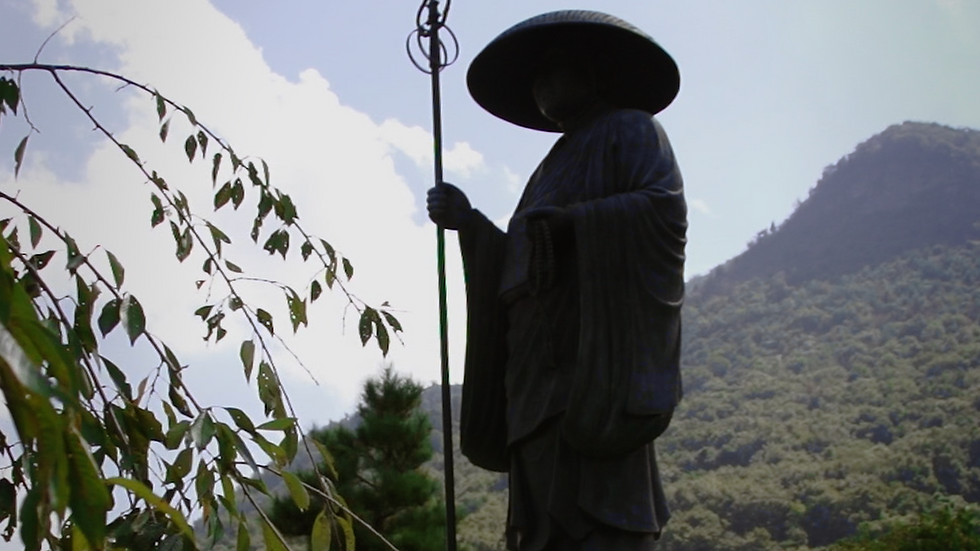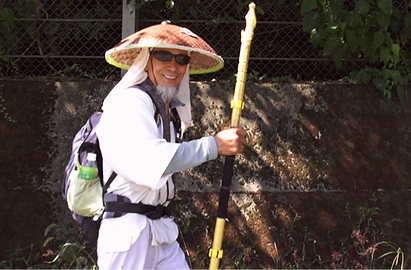
01
THE FILM
Synopsis
There are moments in our lives that we feel lost. We may be longing for change but trapped in old patterns or dealing with depression after a devastating event. For thousands of years, religious pilgrimages have served as one way to help us tackle these universal difficulties. Shikoku, a beautiful island surrounded by clear blue oceans and towered by divine mountains, is known for the backdrop of Japan’s most famous pilgrimage, where 150,000 pilgrims visit annually to complete the 750 mile circuit of 88 temples. It follows some of the same paths once trod by the Japanese Buddhist monk Kukai (A.K.A. Kobo Daishi: 774-835) who introduced the esoteric Shingon doctrine from China. It is said that during the journey, Kukai walks alongside each pilgrim, guiding them according to their needs, and extraordinary things happen.
“Aruku” explores this concept of Kukai’s guidance by documenting chance encounters between the filmmaker and pilgrims. This leaves the fate of the filming to Kukai, just as the pilgrims entrusted their path to him. The filmmaker eventually focuses on four pilgrims whom she felt most connected to on her own 50-day pilgrimage. The pilgrims’ life struggles seem to be reflected while challenging the hardest legs of their long pilgrimage. They are encouraged by the philosophical words written on the path, and at the temples, they recite the Heart Sutra, which describes the Buddhist idea of “emptiness.” Pilgrims tread in the midst of nature, having minimum items with them. Returning to the basics of life in this way, I think we realize what is truly important to us in our lives.

02
BACKGROUND
About Kukai
Kukai ( A.K.A. Kobo Daishi: 774-835) : Born to an aristocratic family in Shikoku, Kukai was educated in Chinese classics and Confucianism. As a young priest, Kukai distanced himself from the government-controlled Buddhist schools, isolated himself in the forests of Shikoku, and immersed himself in nature to seek out Buddhism’s true meaning. The story of Kukai’s enlightenment tells of a bright star that flew into his mouth while he was reciting meditation in a cave. Because he could see only the sky and the sea from the cave, he received the Dharma name of "Ku (sky) kai (sea).” Later, Kukai traveled to China and received initiation from a famed Buddhist master, and brought back the teachings of Esoteric Buddhism to Japan. Kukai started the innovative Shingon sect, opened its doors to everyone, and became a key figure in the flowering of Japanese culture during the Heian period. After his physical death, many myths were told celebrating his achievements. The original Shikoku pilgrimage was started by monks who followed in the footsteps of Kukai, and it is said that his spirit is still alive as an eternal grand master.

About Shikoku
Shikoku is the smallest of Japan’s four main islands, lying in the southwestern part.
It is situated between the Seto Inland Sea and the Pacific Ocean. Shikoku means
“Four Kingdoms,” comprising the four prefectures, Tokushima, Kochi, Ehime, and Kagawa.
About Shikoku Pilgrimage
The Shikoku Pilgrimage is deeply ingrained in the culture of the island. In the 12th century, the first references to the Shikoku Pilgrimage appeared in documents, but the exact route was not specified. Later, in the 16th and 17th centuries, the current incarnation of the Pilgrimage came to be. The route traversing the four prefectures is also one of the few circular-shaped pilgrimages in the world. To complete the full Pilgrimage of 750 miles, one would begin from the first temple, travel all 88 temples, then circle back to the first temple. However, it is not always necessary to visit the temples in order. It takes around 30 to 60 days to complete the circle by foot. While walking is the traditional way to complete the path, cars, motorcycles, and tour buses can be combined.
People’s motives for making this pilgrimage vary. Some have religious reasons, and some join for recreation. Some go to pray for deceased souls. And, recently, more people have rediscovered it as a healing journey. The white attire worn by the pilgrims represents purity and innocence. It also symbolizes a death shroud, as the pilgrim is prepared to die at any time. Each year about 150,000 pilgrims embark on this spiritual journey, and the number of younger generations and foreign pilgrims continues to increase. In Shikoku, there is a custom of “Osettai,” which is an offering of food, drinks, and lodging to pilgrims from local residents. The reason for this is to revere the pilgrims as the reincarnation of Kukai.

03
THE MISSION
Artistic Statement
I discovered the Shikoku Pilgrimage from my grandmother who was a pilgrim and completed the path three times. My interest in the pilgrimage increased when I reached my 30s and started thinking about the meaning of my life. I finally decided to film the pilgrimage myself just before my 40th birthday, longing to challenge my dream of making my own film after working as a TV director for over a decade. I felt stuck and in need of change. As a TV director, filming a documentary usually requires a story line which one must adhere to while following strict deadlines. My intention with “Aruku” was to break from the rules and pick up characters through chance encounters, capturing their journey spontaneously as I also walked an average of 12 miles a day for 50 days. Besides having a production assistant transporting camera equipment and our luggage, I was the sole artist for the entire documentary meeting pilgrims serendipitously as I walked.
“Aruku” focuses on protagonists facing issues which much of modern society deals with: workplace burnout, employment insecurity, the inability to form lasting relationships, loneliness… In such situations, we eventually ask, "How can we be happy?“ “How should we live?” Buddhism has always been a source of inspiration for attaining happiness. In the United States where I reside, the number of people practicing meditation has been increasing over the past decades to learn concepts like living in the present, impermanence and selflessness, as well as equanimity of mind. I believe it is because looking within is a very effective way to overcome various hardships and dissatisfactions.
In 2020, the pandemic shook the world and presented all of us with unprecedented challenges. It made us see the world differently from before, and rethink how we live. Many of us started walking in nature or joined the BLM protests. In a sense, it made us all pilgrims as we began to look for meaning. The practice of walking was renewed as a way to make change and overcome hardships. By observing how these pilgrims confront questions fundamental to humanity, I hope the film offers food for thought to anyone thinking about their own direction in life.
04
MAIN CHARACTERS


Hiroe Nagai (30) is a pharmacist who has taken a break from her 10 year career. She’s been in a state of mental and physical imbalance due to the daily grind of work and inability to find a life partner. Nagai treats the Pilgrimage as an extreme Buddhist practice, treading rigorously and engaging in intense ascetic training. Although gaining clarity as she progresses, Nagai cannot help noticing the distractions surrounding her, including the video camera with the filmmaker that follows.
Shoji Takaoka (23) appears filming himself screaming the name of each temple along the route. He is depressed after being fired from his first job at a video production company. Borrowing his mother's bicycle, he undertakes his adventure on two wheels. Besides visiting temples, Takaoka works on his visual art projects, documenting freely what he finds and feels along his journey. Gradually, this renews his courage to take on challenges when he returns.


Li Kai (27) is a Chinese exchange student who just arrived in Japan and proclaims himself “a disciple of Kukai.”
Although his Japanese is minimal, Li manages the path successfully relying on his natural instincts and Buddhist spirit. Parallel to Kukai’s excursion to China over thousands years ago, Li came to Japan to explore the world. As we follow him and observe his love of nature and all beings, it is as though we are looking at a reincarnation of Kukai.
Mukoh Miyama (72) is the Buddhist name he gave himself, translated to “I don’t mean to be enlightened.” Retiree
Miyama is resigned to a distant relationship with his family
after a job posting separated him from home. He has been
doing the Pilgrimage continuously for 3 years and has already completed 35 circuits. His special method of going around the path is to make round trips between temples while using his minivan as shelter, and he often cleans up the path as he walks.